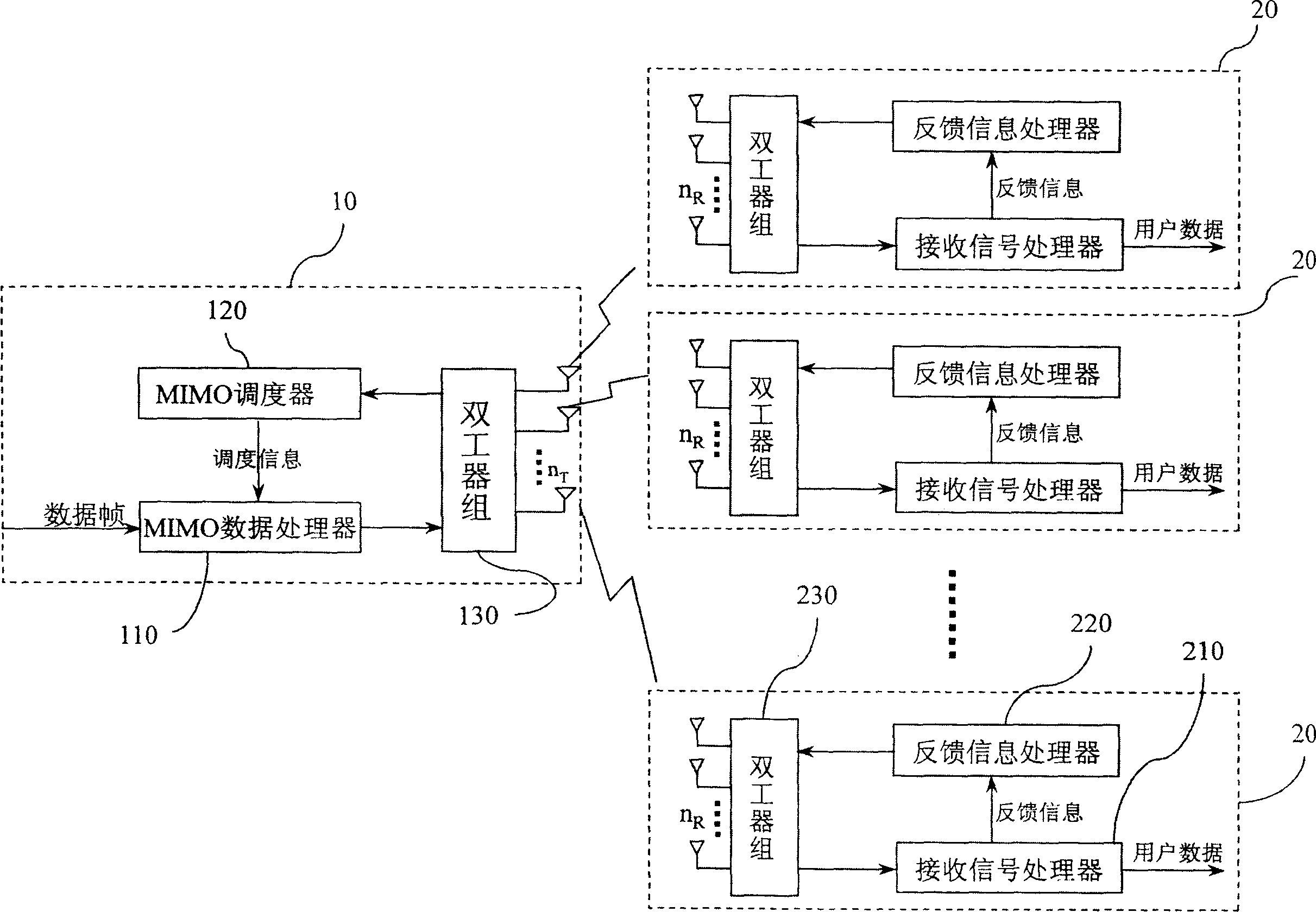MIMO telecommunication system and user sheduling method
A communication system and user technology, applied in transmission systems, multiplex communication, radio transmission systems, etc., can solve the problems of inability to adjust the number of users, system performance loss, high system capacity, etc. System capacity, the effect of improving system capacity
- Summary
- Abstract
- Description
- Claims
- Application Information
AI Technical Summary
Problems solved by technology
Method used
Image
Examples
no. 1 Embodiment
[0045] figure 1 It is a frame diagram of an adaptive scheduling MIMO communication system based on antenna selection in the present invention, wherein the adaptive scheduling MIMO communication system includes a transmitting end 10 (base station) and multiple receiving ends 20 (users). figure 2 for figure 1 Flowchart of adaptive scheduling for the shown MIMO communication system. image 3 It is a schematic diagram of the frame structure adopted by the MIMO communication system.
[0046] Such as Figure 1-3 As shown, the transmitting end 10 has a MIMO data processor 110, a MIMO scheduler 120, a duplexer group 130 and n T Root transmit antenna. Each receiver 20 has a received signal processor 210, a feedback information processor 220, a duplexer group 230, and n R Root receiving antenna. Wherein, the number of receiving antennas of each receiving end 20 may be different. The frame structure includes: channel estimation time slots, channel feedback time slots and data tra...
no. 2 Embodiment
[0102] The second embodiment of the present invention is an adaptive scheduling MIMO communication system based on beamforming. The structure of the MIMO communication system, the adaptive scheduling method and the adopted frame structure can be roughly referred to in the first embodiment Figure 1 to Figure 3 . Since the adaptive scheduling MIMO communication system in the second embodiment is based on beamforming, it is different from the adaptive scheduling MIMO communication system based on antenna selection in the first embodiment in terms of implementation. Hereinafter, the MIMO communication system of the second embodiment will be described in detail with reference to the drawings. Wherein, the same reference numerals indicate elements with the same or similar functions.
[0103] Such as figure 1 As shown, the adaptive scheduling MIMO communication system based on random transmit beamforming includes a transmitting end 10 (base station) and multiple receiving ends 20...
no. 3 Embodiment
[0145] The third embodiment will illustrate the antenna selection-based semi-adaptive scheduling MIMO communication system and the semi-adaptive scheduling method of the present invention.
[0146]The structure of the semi-adaptive scheduling MIMO communication system based on antenna selection in the third embodiment is roughly similar to the structure of the adaptive scheduling MIMO communication in the first embodiment in FIG. In addition to generating scheduling information, the MIMO communication system also needs to compare communication capacity and insert feed-forward information (assumed to be 1 bit, of course, can also be multiple bits) in the frames sent in each scheduling time slot. Therefore The scheduler needs to be configured accordingly. The feedforward information is inserted or multiplexed before the channel estimation signal of the frame by a multiplexer (the data corresponding to the channel estimation signal increases the length of the feedforward informat...
PUM
 Login to View More
Login to View More Abstract
Description
Claims
Application Information
 Login to View More
Login to View More - R&D
- Intellectual Property
- Life Sciences
- Materials
- Tech Scout
- Unparalleled Data Quality
- Higher Quality Content
- 60% Fewer Hallucinations
Browse by: Latest US Patents, China's latest patents, Technical Efficacy Thesaurus, Application Domain, Technology Topic, Popular Technical Reports.
© 2025 PatSnap. All rights reserved.Legal|Privacy policy|Modern Slavery Act Transparency Statement|Sitemap|About US| Contact US: help@patsnap.com



